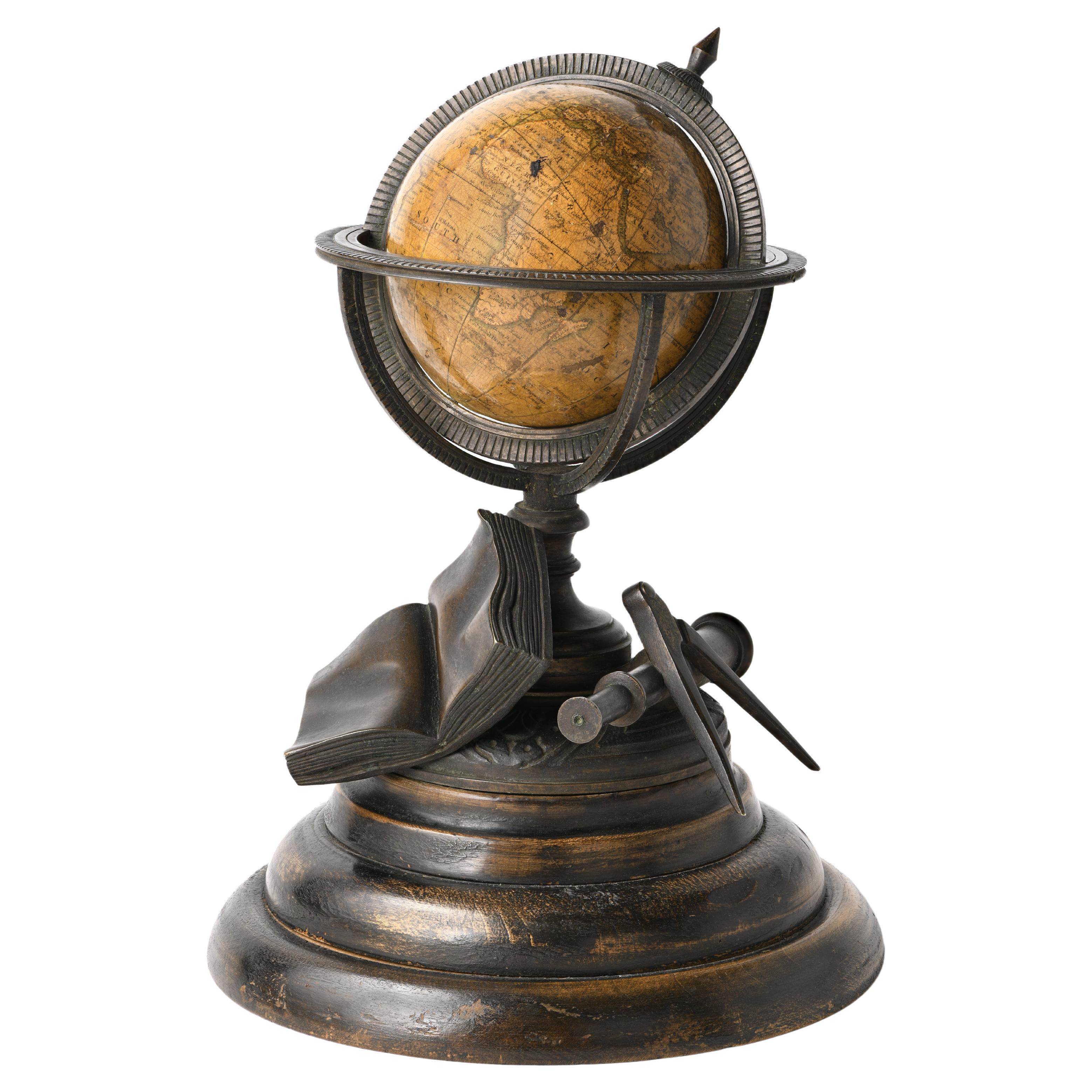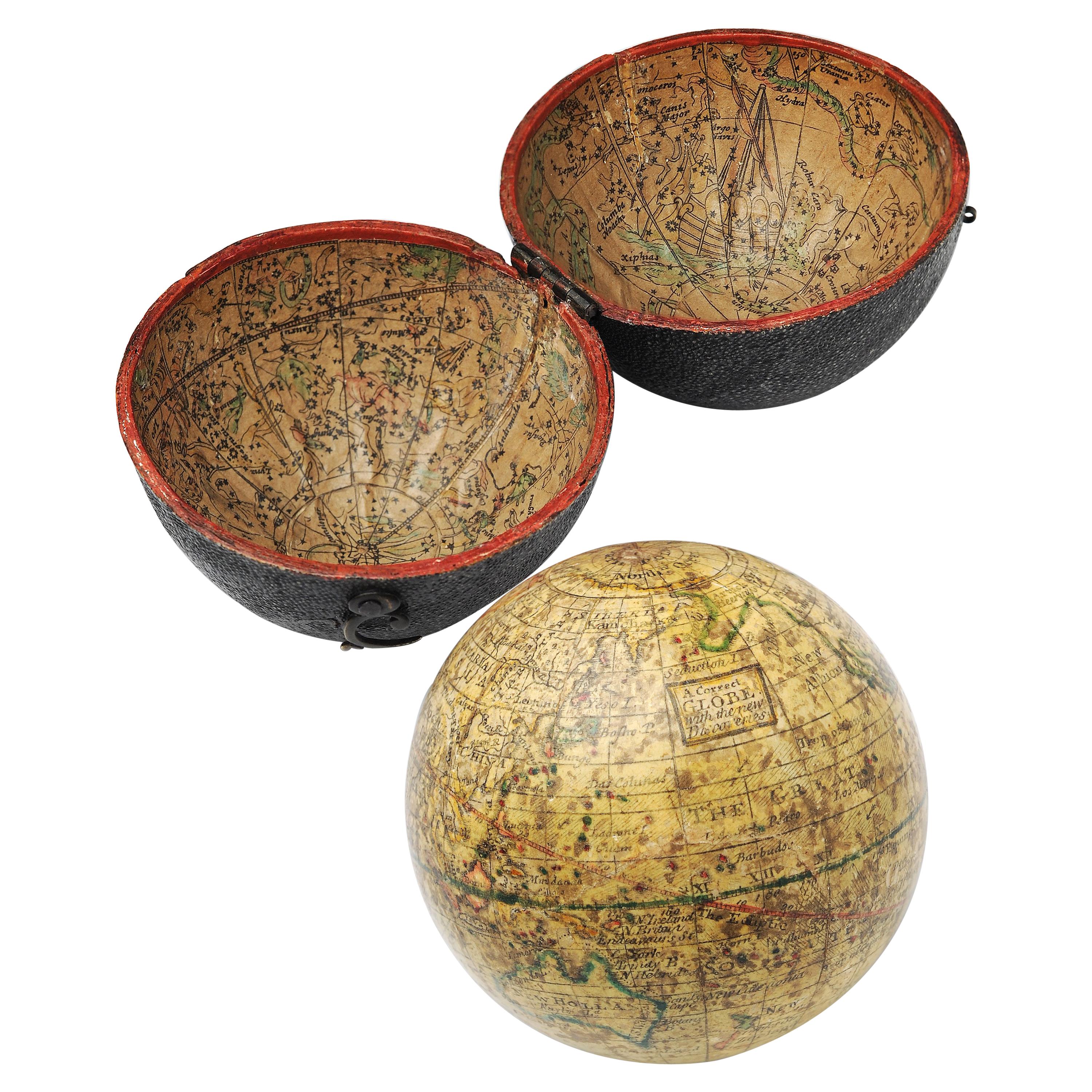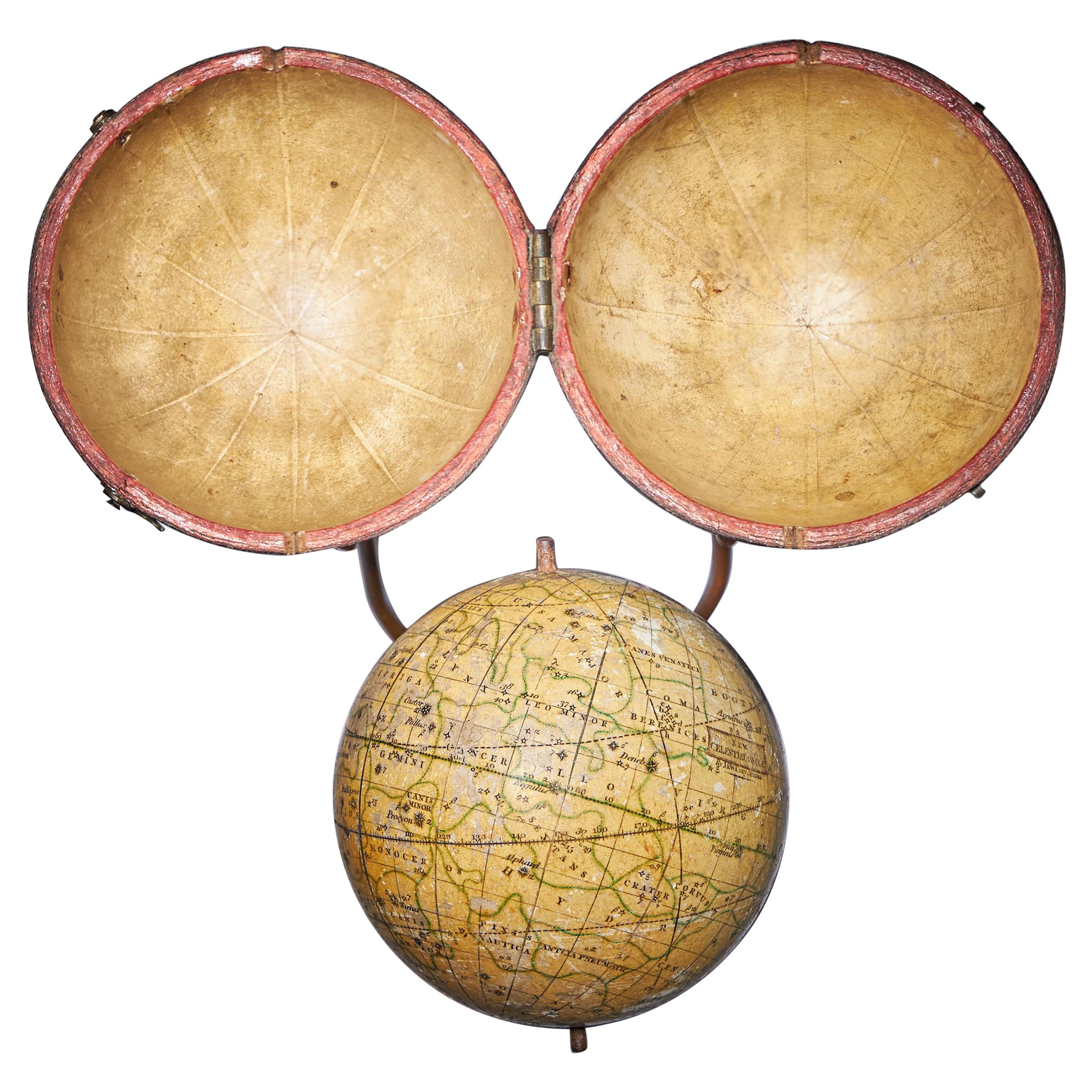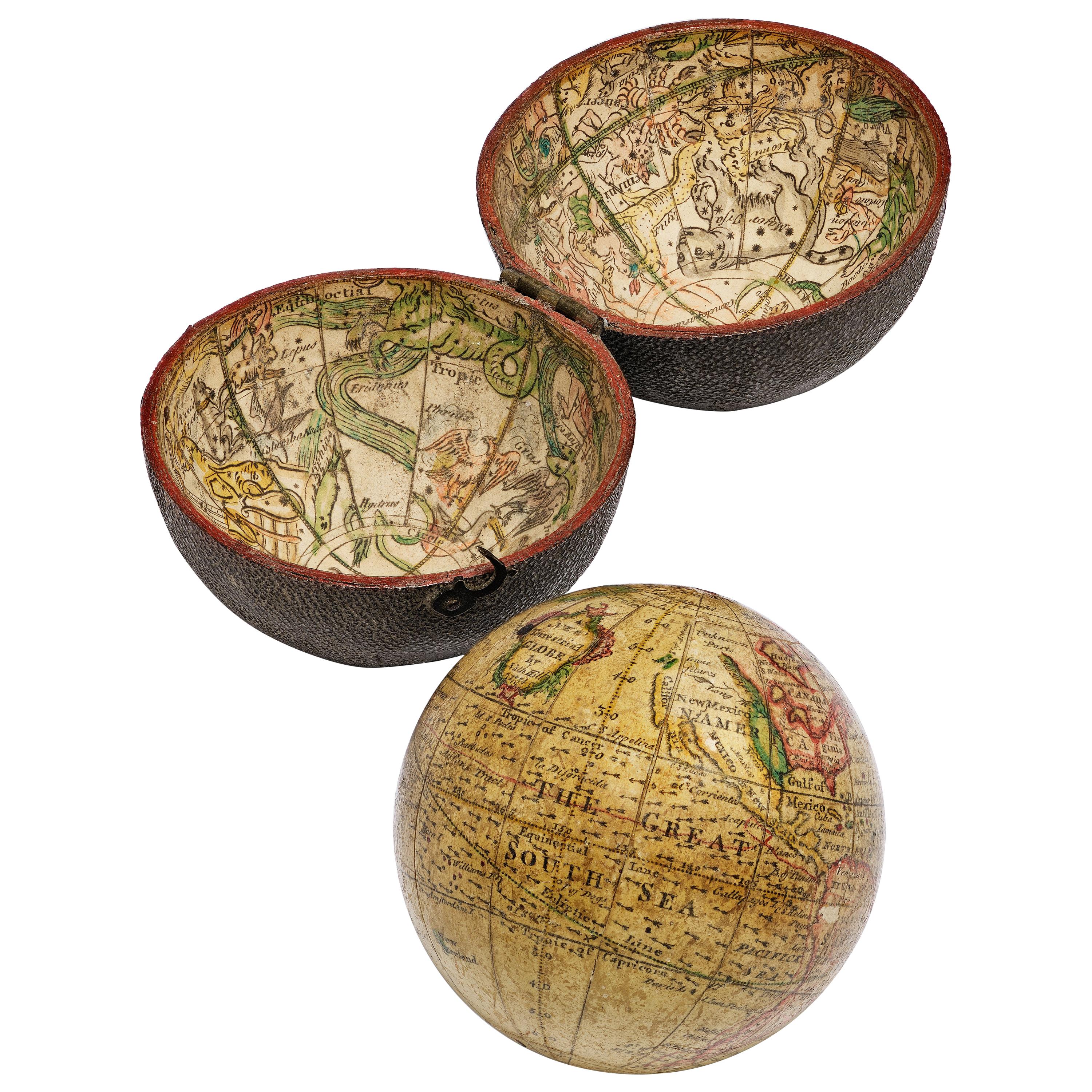Items Similar to Georgian Terrestrial Pocket Globe by T. Harris and Son, London, 1813
Want more images or videos?
Request additional images or videos from the seller
1 of 13
Georgian Terrestrial Pocket Globe by T. Harris and Son, London, 1813
About the Item
A Rare George III pocket globe by T. Harris and Son, London, 1813. Housed in the original sharkskin case.
A fasinsting and rare item in wonderful condition.
The terrestrial globe inscribed 'New Terrestrial Globe By T.Harris and Sons 1813' rotates on its axes inside a hinged black shagreen case. The concave interior of the case applied with the engraved celestial charts of the Northern and Southern skies and depictatioins of the symbols of Zodiac.
The Harris family — Thomas Harris (d. 1837) and his son William Harris (1797-1846) — were London opticians who also sold and later produced terrestrial and celestial globes. Initially, Thomas Harris was principally an optician and mathematical instrument maker. He was joined, and then succeeded, by William in the early 19th century. According to scholar Elly Dekker, Harris & Son was in business from 1802 to 1907. The firm is known to have sold a Lane pocket globe, dated 1809 under the name Harris, 47 Holborn. A different extant table globe was produced by the firm under the name W. Harris, 22 Cornhill, London. In 1820, as Thomas Harris and Son, the firm produced "A New Celestial Globe," 12 inches in diameter. According to the cartouche of that globe the firm marketed itself as "Opticians and Globe Makers; To his Majesty and their Royal Highnesses The Dukes of Kent and Sussex." At that time the firm's address was 52 Great Russell Street, Bloomsbury, London.
See my other listings for a celestial globe by Cary.
- Dimensions:Height: 3 in (7.62 cm)Diameter: 3 in (7.62 cm)
- Style:George III (Of the Period)
- Materials and Techniques:
- Place of Origin:
- Period:Early 19th Century
- Date of Manufacture:1813
- Condition:Wear consistent with age and use. Wonderful original condition including the lacquer.
- Seller Location:Oxfordshire, GB
- Reference Number:1stDibs: LU4936233082662
About the Seller
5.0
Recognized Seller
These prestigious sellers are industry leaders and represent the highest echelon for item quality and design.
1stDibs seller since 2019
20 sales on 1stDibs
Associations
LAPADA - The Association of Arts & Antiques Dealers
- ShippingRetrieving quote...Ships From: Faringdon , United Kingdom
- Return PolicyA return for this item may be initiated within 14 days of delivery.
More From This SellerView All
- Rare George III Celestial Pocket Globe by Cary, LondonBy CaryLocated in Oxfordshire, United KingdomA fine and rare 3" celestial pocket globe by G & W Cary, Strand, London circa 1791, housed in its original sharkskin case. A companion globe to terrestrial globes of this type we...Category
Antique Late 18th Century English George III Aviation Objects
MaterialsPlaster
- George III Mahogany Stick Barometer by Noted London MakersBy William JonesLocated in Oxfordshire, United KingdomA fine George III mahogany stick barometer by noted London makers William & Samuel Jones. The mahogany-veneered case has an austere form with only the moulded caddy top and the u...Category
Antique Early 19th Century English Georgian Wall Clocks
MaterialsMahogany
- From Queen Charlotte, A Rare Miniature Gold Mounted George III Almanac, 1817Located in Oxfordshire, United KingdomA present from Queen Charlotte given to Ann Dundas, Viscountess Melville, The Viscountess was Queen Charlotte’s Lady of the Bedchamber from 1813 until the Queen’s death in 1818. Lond...Category
Antique Early 19th Century English George III Models and Miniatures
MaterialsGold
- From Queen Charlotte, A Rare Miniature Gold Mounted George III AlmanacLocated in Oxfordshire, United KingdomA presents from Queen Charlotte given to Ann Dundas, Viscountess Melville, The Viscountess was Queen Charlotte’s Lady of the Bedchamber from 1813 until the Queen’s death in 1818. Lon...Category
Antique Early 19th Century English George III Models and Miniatures
MaterialsGold
- 17th Century Lantern Alarm Clock by Johannes Quelch, OxfordLocated in Oxfordshire, United KingdomAn English 17th century lantern clock made of brass and iron, circa 1665-1670. The clock consists of going and striking trains, as well as a...Category
Antique 17th Century British Baroque Wall Clocks
MaterialsBrass
- Striking George IV Eight-Day Rosewood Pagoda Library Clock by French, LondonBy Santiago James Moore FrenchLocated in Oxfordshire, United KingdomThis lovely small library clock has a spring-driven eight-day twin chain-fusee movement with going and striking trains. The going train has anchor escapement with a short pendulum and stirrup regulation to facilitate adjusting the timing, which is accessible from the back. The rack striking indicates the hours of a gently sounding bell, which can be repeated at all times by pulling a cord to the side of the case. The elegant chased and engraved arched gilt brass dial has a Roman chapter ring with five-minute and minute divisions. The maker has signed the dial above the middle: FRENCH ROYAL EXCHANGE...Category
Antique Early 19th Century George IV Mantel Clocks
MaterialsBrass
You May Also Like
- Miniature Terrestrial Globe Newton & Son London, Post 1833, Ante 1858By Newton and SonLocated in Milano, ITMiniature Terrestrial Globe Newton & Son London, post 1833, ante 1858 Paper, papier-mâché, bronze and wood It measures: sphere diameter 2.95 in (7.6 cm); diameter of the wooden base 6.02 in (15.3 cm); height 8.36 in (21.24 cm). Weight: 2,067 lb. State of conservation: the globe still bears its original paint, but has various small gaps, abrasions and stains on the surface. The globe is hinged with two pins at the meridian circle, which is in turn inserted perpendicular to the horizon circle; this is supported by four semi-arches connected at the bottom by a small goblet-shaped foot, resting on a wooden bell-shaped base. Apart from the wooden base, the entire support structure is made of bronze; on the foot there are the scale reproductions of a compass, a telescope and an open book. The sphere is made of papier-mâché and is covered with twelve printed paper gores. In the North Pacific Ocean the globe bears a cartouche with the inscription (about 30% of the writing is illegible, but the missing parts can be easily integrated based on the rest): NEWTON’S New & Improved TERRESTRIAL Globe Published by Newton & Son 66 Chancery Lane LONDON On the globe, much of central Africa is empty and the great lakes Tanganyika and Victoria are not marked (Europeans would begin to explore the area after 1858). Canada is called "British Territory" and Alaska "Russian Territory" (it would become part of the United States in 1867). Australia already bears its modern name (until 1829 it had been called New Holland) and its coasts are completely designed; Tasmania is listed as an island (Matthew Flinders circumnavigated it in 1798). The routes of Cook's various voyages are plotted; both the route followed by Biscoe in 1831 and the "Land of Enderby" which he discovered on the coast of Antarctica, south of Africa, are marked. Bibliography P. Van der Krogt, Old Globes...Category
Antique 1840s English Early Victorian Maps
MaterialsBronze
- English Pocket Globe, London, Circa 1775-1798By Herman MollLocated in Milano, ITPocket globe London, between 1775 and 1798 Re-edition of the globe of Hermann Moll (1678-1732) dated 1719 The globe is contained in its original case, which itself is covered in sh...Category
Antique Late 18th Century English George III Globes
MaterialsShagreen, Paper
- Pocket Globe by Nathaniel Hill, London 1754Located in Milano, ITNathaniel Hill Pocket globe London, 1754 The globe is contained in its original case, which itself is covered in shark skin. There are slight gaps in the original paint on the sphere. The case no longer closes. The sphere measures 2.6 in (6.8 cm) in diameter whereas the case measures 2.9 in (7.4 cm) in diameter. lb 0.24 (kg 0.11) The globe is made up of twelve printed paper gores aligned and glued to the sphere. In the North Pacific Ocean there is a scroll with the inscription: A New terrestrial Globe by Nath. Hill, 1754. The celestial globe is depicted on the inside of the box. On the terrestrial globe much of central and southern Africa is empty. North America bears only the name of some British colonies. It shows California as a peninsula and the northwest coast of America as "unknown parts" (Alaska is not described and is only partially delineated; it would become part of the United States in 1867). The route of Admiral Anson is traced (1740) and the trade winds are indicated by arrows. Australia, still named New Holland (the new name would be introduced in 1829), is part of the west coast. (See Van der Krogt, P., Old Globes in the Netherlands, Utrecht 1984, p. 146 and Van der Krogt, P. - Dekker, E., Globes from the Western World, London 1993, p. 115.) Nathaniel Hill (London, news from 1746 to 1768) had impeccable professional credentials: he had done his apprenticeship with Richard Cushee, who at the time was carrying out surveying work for John Senex's Surrey map...Category
Antique 1750s English George II Globes
MaterialsShagreen, Paper
- 19th Century German Miniature Pocket Terrestrial GlobeBy C. Abel-KlingerLocated in Essex, MAA miniature 19th century 3.5 inch diameter pocket terrestrial globe by C. Abel-Klinger, Nuremberg, Germany, in English for the English speaking markets. Signed with cartouche reading...Category
Antique 1880s German Scientific Instruments
MaterialsBrass
- Pair of English Globes by Cary, London, 1798 and 1800By Cary’sLocated in Milano, ITPair of 12-inch table globes John and William Cary London, 1798 and 1800 Some restored cracks and abrasions lb 11 each (kg 5) The two terrestrial and celestial globes rest in their original Dutch style stands with four supporting turned wood columns. Each one measures 18 in in height x 17 in in diameter with the diameter of the spheres measuring about 12 in; 46 cm in height x 43 cm in diameter x 31 cm diameter of the spheres. The 12 inch measure was one of the most frequently used by British manufacturers of globes of this period. Each globe is composed of two series of twelve printed paper gores, aligned and glued onto plaster spheres. The brass circle of the meridian bears engravings...Category
Antique Late 18th Century English George III Globes
MaterialsWood, Paper
- Large and Extremely Rare Terrestrial Globe by NewtonBy Newton Globes - Planer & NewtonLocated in Lymington, HampshireA large and extremely rare 24-inch terrestrial globe by Newton Our most magnificent and rare globes were a pair of 24-inch Newton globes. These too were updated in 1852 (terre...Category
Antique Mid-19th Century English Globes
MaterialsMahogany
Recently Viewed
View AllMore Ways To Browse
Antique Pocket Globe
Antique Chart Table
Boeing 747 Scale Model
Douglas Destroyer
Hawker Hunter
Hermes Rocket
Longines Field Watch
P38 Lightning
P51 Mustang
Rolex Aviator Vintage
Vintage Leather Pilot Helmet
Martin Baker Mk4
Aviation Goggles
Ww2 Airplane
B 29 Bomber
Vintage Aviation Decor
Vintage Leather Goggles
Vintage Winged Wheel





